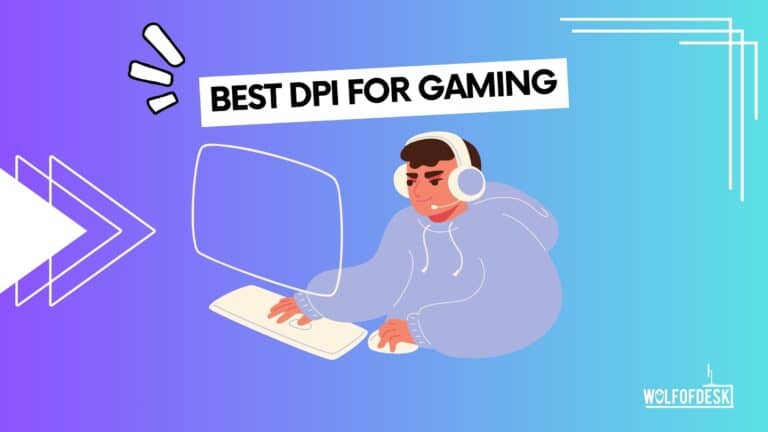A gamer’s success often depends on small details. A split second can mean the difference between a glorious victory and a frustrating defeat. That’s why Gamers are always on the hunt for that extra edge, and one question keeps popping up: What’s the best DPI for gaming?
DPI, short for Dots Per Inch, is a critical setting that controls how fast your mouse moves your cursor on the screen. It’s a hot topic in the gaming world, with different opinions flying around.
Some favor super high DPI settings, saying they provide unmatched accuracy, while others prefer lower settings for more precise control.
So, let’s break down which DPI is the best, how it affects your gameplay, and how to choose the right DPI for you.
What the Heck Is DPI?
DPI stands for “Dots Per Inch,” which tells you how many pixels your cursor moves on the screen when you move the mouse by just one inch. So, if you have a mouse with 1900 DPI, it means the cursor moves 1900 pixels for every inch you move the mouse.
If you’re still confused, just take it as DPI, a speed setting for your computer mouse. It tells you how fast or slow the cursor moves on the screen compared to how much you move the mouse.
And don’t get confused between DPI and CPI. The CPI is Counts Per Inch. Basically, both determine how quickly your cursor moves when you move your mouse.
The Best DPI Setting for Gaming

When it comes to the best DPI for gaming, I say it’s a matter of personal preference. It’s best to test a mouse’s full range to find what works best for them.
Many gaming mice come with a DPI button that lets you cycle through different levels, often starting low and going high. Some even let you customize it through an app.
But wait! There’s another thing you need to know: your monitor’s resolution affects DPI. Here’s a basic rule: If you have a 4K monitor, which has four times as many pixels as a 1080p screen, a mouse set to 1600 DPI will feel much slower on the 4K monitor than on the 1080p one.
So, when picking your DPI, think about your monitor’s resolution and then decide. If you’re still unsure which DPI you should go with, we will help you determine the best DPI for your needs.
Make an experiment and test different DPI settings until you find the perfect one for yourself. I say, test your own preferences instead of following general recommendations.
Should You Go High DPI?
High DPI settings can be really useful for fast mouse movements in games, especially when you need quick reflexes and want to perform impressive moves. They reduce the need to move your mouse a lot. Additionally, high DPI works well on 4K screens, giving you precise control for other tasks.
However, high DPI may not be the best choice for super precise shooting games. It can make your cursor move too quickly, making it hard to aim accurately.
So, if you’re into gaming, high DPI might not be your best friend. Instead, consider using a lower DPI setting for more accurate aiming. You can see a huge improvement in your performance if you do it.
Should You Prefer Low DPI?
Low DPI provides excellent cursor control while cutting down on speed, making it ideal for precision-demanding tasks such as those in online FPS games.
Low DPI also works well if you have a large desk space and are comfortable with broad mouse movements. It covers more screen area with less effort.
Many pro esports players use low DPI settings (e.g., 400 or 800 DPI) and wide arm movements for precise mouse control.
Using a low DPI setting is perfectly fine. So, if it feels comfortable and works for you, stick with it.
What’s The Difference Between DPI and Sensitivity?
I know that many users are quite confused between DPI and Sensitivity. However, it isn’t hard to tell what the difference is between them.
DPI (Dots Per Inch) is a hardware setting that determines the mouse’s sensitivity, measuring cursor movement in pixels per inch.
Higher DPI results in faster cursor movement and is adjustable via manufacturer software or through the button on the mouse.
However, Sensitivity, a software setting in games or the OS, controls how the cursor or in-game view reacts to mouse movement as a multiplier or percentage.
Lower sensitivity slows movement relative to mouse motion, while higher sensitivity speeds it up.
Almost all games provide customizable sensitivity. DPI and sensitivity together define your mouse’s behavior, creating a fine balance between speed and precision.
Best DPI And Sensitivity For Precision Aim
DPI (Dots Per Inch) is a seriously important setting that can make or break your gaming performance and style. Let’s explore how to tweak your DPI for top-notch gaming and level up your skills.
It’s kind of like this: when you’re in a game, the DPI setting can really mess with how your sensitivities feel. Playing at 10 sensitivity with 400 DPI is pretty much identical to playing at 5 sensitivity with 800 DPI.
So if you decrease sensitivity, you will need to increase the DPI setting to get optimal performance.
Let’s break it down: Pro players use something called eDPI, which is just DPI multiplied by in-game sensitivity. For example, at 400 DPI, their eDPI is 243. If they use 800 DPI, it jumps to 302. And for 1600 DPI, it goes even higher to 395.
In games with minimal movement, like Valorant and CS:GO, lower sensitivity usually works better. But in games with lots of action and jumping around, like Fortnite, higher sensitivity tends to be the way to go.
What DPI Settings Do Professionals Set For Gaming?
I know you guys might be curious about the DPI setting of the Pro gamers. Professional gamers choose DPI settings based on their game and personal preferences.
However, it’s common to see professional gamers using DPI settings in the range of 400 to 1600 DPI. Some might even go beyond 1600 DPI, but it’s less common.
Here are the some mice and DPI settings for some well-known professional gamers as of that time.
- Ninja (Tyler Blevins): Ninja prefer 800 DPI. And Ninja uses the Logitech G Pro X Superlight mouse, which is known for its precision and lightweight design.
- Shroud (Michael Grzesiek): Shroud has been known to use a DPI setting of 800; it uses a LOGITECH PRO X 2 LIGHTSPEED mouse.
- S1mple (Oleksandr Olehovych Kostyliev): S1mple uses a Logitech G Pro X Superlight Magenta with a DPI: 400.
The Logitech G PRO X SUPERLIGHT Wireless Gaming Mouse redefines precision and speed in gaming. It’s designed for competitive gamers seeking unparalleled performance, featuring a lightweight build and top-tier sensor technology. It’s being used by many professional gamers these days.
FAQ
Is 1200 DPI enough?
Yes, A DPI setting of 1200 is great for gaming, and many pro gamers use it. It helps with precise aiming and responsive movements, making it a good choice.
Remember, different gamers have different tastes, but I’d say that most of them tend to stick with a DPI setting in the range of 800 to 1200. The reason? Well, lower DPI settings in this range are the secret weapon for superb precision aiming in first-person shooters.
However, you can often change your mouse’s DPI while gaming, and the right setting depends on your game, screen, and how you play. Ultimately, it’s a matter of what feels right to you.
Is 600 DPI good for FPS gaming?
Yes, a DPI setting of 600 can be good for FPS (first-person shooter) gaming. Many gamers prefer lower DPI settings like 400-800 for precise aiming in FPS games because it allows for slower, more controlled movements, which can be advantageous when aiming at small targets.
A 600 DPI setting is user-friendly and easy to get used to. If you pair it with a larger mouse pad and set your DPI at around 600, it can positively impact your aiming accuracy in your favorite games.
What’s the difference between DPI and eDPI?
DPI (Dots Per Inch) and eDPI (Effective Dots Per Inch) are big deals in gaming sensitivity. DPI is all about your mouse’s physical sensitivity. It tells you how many dots, or pixels, your cursor moves on your screen for every inch you move your mouse on your pad.
In contrast, eDPI calculates your effective sensitivity by multiplying your mouse’s DPI with your in-game sensitivity settings. This combination offers a standardized measure, considering both hardware and software preferences.
DPI is a fixed hardware setting, while eDPI is adjustable through in-game settings. Gamers commonly use eDPI for consistency across different games, maintaining a constant sensitivity level while adapting in-game settings to suit various scenarios.
Conclusion
So whatever the mouse you have or whatever the game you like to play, the best gaming DPI setting always depends on you.
Yes! This all depends on your personal preference. There’s no one-size-fits-all answer. You can try different precision settings using software to find what works best for you.
If you ask me, some mice can have extremely high DPI settings, like 20,000 or more, but these really only make sense if you have an 8K monitor. For most people with 1080p or 1440p monitors, DPI settings of 1600 or higher are often more than enough because these monitors have lower resolutions.
So, it’s up to you to decide what DPI setting feels right for your gaming style. And if you’re confused about the best gaming mouse, you can take a look here.
Related Articles:
Best Vertical Mouses
Best Gaming Mouse with Side Buttons



